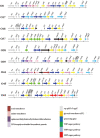Genetic Analysis and Serological Detection of Novel O-Antigen Gene Clusters of Plesiomonas shigelloides
- PMID: 33746188
- PMCID: PMC9723277
- DOI: 10.4014/jmb.2010.10008
Genetic Analysis and Serological Detection of Novel O-Antigen Gene Clusters of Plesiomonas shigelloides
Abstract
Plesiomonas shigelloides, a member of the family Vibrionaceae, is a gram-negative, rod-shaped, facultative anaerobic bacterium with flagella. P. shigelloides has been isolated from such sources as freshwater, surface water, and many wild and domestic animals. P. shigelloides contains 102 Oantigens and 51 H-antigens. The diversity of O-antigen gene clusters is relatively poorly understood. In addition to O1 and O17 reported by other laboratories, and the 12 O serogroups (O2, O10, O12, O23, O25, O26, O32, O33, O34, O66, O75, and O76) reported previously by us, in the present study, nine new P. shigelloides serogroups (O8, O17, O18, O37, O38, O39, O44, O45, and O61) were sequenced and annotated. The genes for the O-antigens of these nine groups are clustered together in the chromosome between rep and aqpZ. Only O38 possesses the wzm and wzt genes for the synthesis and translocation of O-antigens via the ATP-binding cassette (ABC) transporter pathway; the other eight use the Wzx/Wzy pathway. Phylogenetic analysis using wzx and wzy showed that both genes are diversified. Among the nine new P. shigelloides serogroups, eight use wzx/wzy genes as targets. In addition, we developed an O-antigen-specific PCR assay to detect these nine distinct serogroups with no cross reactions among them.
Keywords: O-antigen gene clusters; PCR assay; Plesiomonas shigelloides; serogroups.
Conflict of interest statement
The authors have no financial conflicts of interest to declare.
Figures





Similar articles
-
O-Antigen Gene Clusters of Plesiomonas shigelloides Serogroups and Its Application in Development of a Molecular Serotyping Scheme.Front Microbiol. 2019 Apr 10;10:741. doi: 10.3389/fmicb.2019.00741. eCollection 2019. Front Microbiol. 2019. PMID: 31024508 Free PMC article.
-
The complete DNA sequence of the O antigen gene region of Plesiomonas shigelloides serotype O17 which is identical to Shigella sonnei form I antigen.Microbiol Immunol. 2000;44(3):161-72. doi: 10.1111/j.1348-0421.2000.tb02478.x. Microbiol Immunol. 2000. PMID: 10789503
-
Comparison of O-antigen gene clusters of Escherichia coli (Shigella) sonnei and Plesiomonas shigelloides O17: sonnei gained its current plasmid-borne O-antigen genes from P. shigelloides in a recent event.Infect Immun. 2000 Oct;68(10):6056-61. doi: 10.1128/IAI.68.10.6056-6061.2000. Infect Immun. 2000. PMID: 10992522 Free PMC article.
-
The Plesiomonas shigelloides wb(O1) gene cluster and the role of O1-antigen LPS in pathogenicity.Microb Pathog. 2013 Oct;63:1-7. doi: 10.1016/j.micpath.2013.05.010. Epub 2013 May 31. Microb Pathog. 2013. PMID: 23727162
-
Plesiomonas shigelloides Revisited.Clin Microbiol Rev. 2016 Apr;29(2):349-74. doi: 10.1128/CMR.00103-15. Clin Microbiol Rev. 2016. PMID: 26960939 Free PMC article. Review.
References
-
- Niedziela T, Lukasiewicz J, Jachymek W, Dzieciatkowska M, Lugowski C, Kenne L. Core oligosaccharides of Plesiomonas shigelloides O54:H2 (strain CNCTC 113/92): structural and serological analysis of the lipopolysaccharide core region, the O-antigen biological repeating unit, and the linkage between them. J. Biol. Chem. 2002;277:11653–11663. doi: 10.1074/jbc.M111885200. - DOI - PubMed
-
- Pieretti G, Carillo S, Lindner B, Lanzetta R, Parrilli M, Jimenez N, et al. The complete structure of the core of the LPS from Plesiomonas shigelloides 302-73 and the identification of its O-antigen biological repeating unit. Carbohydr. Res. 2010;345:2523–2528. doi: 10.1016/j.carres.2010.09.007. - DOI - PubMed
MeSH terms
Substances
LinkOut - more resources
Full Text Sources
Other Literature Sources

